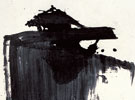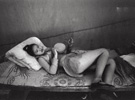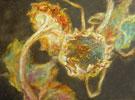
展览时间:2011-11-12 ~ 2011-12-14
展览地点:行云座画廊
策 展 人:成国琴
参展艺术家:张润世
开幕时间:2011-11-12(周六) 15:00~18:00
展览介绍:
引言
张润世画画有一个特点,就是不会取巧,以前看他的版画和插图就有这个感觉,构图和造型都很实在,人物笨笨的,完全是生活中的样子,场景也不修饰,但弄得虚虚实实,好像是老花眼看到的东西。就艺术而言,真正的真实是不存在的,即使是如实的叙事,也是以真实的个人体验为基础,在真实与体验之间的孰重孰轻往往决定真实的变形程度,或主客观的比例程度。
张润世的画有些与众不同,你真要他用理性或规则去控制什么东西对他反而是一件难事。张润世的版画可以用一个“拙”字来概括,这个“拙”不是指技术上的问题,而是造型的特征。在现代绘画中天然的“拙”和“野”是难得的天赋,凡高、卢梭、夏加尔都是这样画的。凡高的早期作品没什么颜色,那股拙劲却很有力量。张润世的拙还是受到规则的限制,他不是有意去拙,而是天性的使然。他的造型有那种土得掉渣的味道,这不是人为的设计,而是天真的眼光和原始的表现,但学院的素描和版画的技术性规则总是遮蔽了他的天性,甚至他自己也没有意识到其中的矛盾。相比而言,张润世的油画就没有那么多的规矩,表达得非常直接。所谓直接就是指颜色的感觉没经过任何规则的过滤直接表达出来。张润世的绘画使 我们感受到他个人的感觉世界的方式,以前我们总是用个性来解释这种风格。一幅好的风景画包含了各种因素,构图的完整,取景的诗意,色彩的和谐,形象的塑造等等。
张润世的色彩显然不是来自大众文化,从他的版画也可以看出他关注的是直接的体验,并不是按照知程式化的造型规则。他的油画人物也是如此,简单概括、天真自然,他不是要表达具体的场景与事件,而是表达绘画本身。确实,张润世的画好像使我们回到早期现代主义,回到凡高、高更那样的绘画。不过,那种早期现代主义的风格充满强烈的个人情绪,似乎是对传统的压制的反叛。张润世的画则是后现代的杂交,大众文化的表现语言与原始感性的个人经验浑然一体,也可能是巧合,他并不想向我们说明任何东西,可能他也是直观地表现了他对大众文化的反应。但是他把这种反应揉入了个人经验,而且是那种原始、天真、朴素的本我。每一件艺术品都可能指示着别处,不论我们怎样在当代文化的共同经验中感受作品 的美,但他的别处不会是那种复制的、包装的格式、而是他个人的存在,那种单纯的、梦幻般的色彩虽然是他的独创,却又是我们共同被遗忘、被淹没的经验。有些东西确实是找不回来了,看看张润世的画,他却是保留了许多。
One characteristic of Zhang Runshi’s painting is that there is nothing gimmicky about it; if we look at his earlier woodblock prints and pictorials, their structure and composition are both realistic; the subjects are cumbersome just as they would be in real life, the background has not been touched-up yet appears to be illusory, as though being seen by weary eyes. From an artistic perspective, there is no truth perse, even the most realistic narrative is based on personal experience. In the weighing of reality and experience, the result often decides the degree of alternating reality, or the ratio of subjectivity to objectivity.
Zhang Runshi’s paintings stand out from the crowd. He would find it difficult if you asked him to produce something rational or in accord with certain principles. This characteristic is reflected in his prints: print-making, a technical and process-oriented art, becomes rather sentimental in his hands. Even though he may have intended to follow certain principles, Zhang Runshi’s prints can be summed up with the word “Clumsy”. It is not a clumsiness that comes from techniques, instead, it is a characteristic of his composition. “Clumsiness” and “Wildness” are, actually, rare attributes in contemporary art. Van Gogh, Rousseau, and Chagall all painted in this way. Van Gogh’s earlier works contained few colors, but their clumsiness was powerful. Zhang Runshi’s clumsiness is somewhat limited by principles, he is naturally rather than intentionally clumsy. His compositions are almost excessively backward; they are show intentional design, but naïve perspective and original representation.
The excellence of a landscape painting depends on various factors: completeness in composition, poetry in scenery, harmony in color, the formation of figures, etc. a poor landscape painting lacks these features. Similarly, a unique landscape painting should break through these factors. Zhang Runshi’s paintings reveal this unique quality, but they are also rather close to the edge of being “bad paintings”. “Dawn at the Back of the East Village” is this kind of work. The composition is unclear, yet one can somehow identify a scene, trees, houses, a small path, a pond, even horses and people—all of which are not what he wanted to represent. Rough brushwork sweeps over the image with mixed colors, the co-existence of red and green seems extremely unharmonious, and a heavy black is also mixed in. what is Zhang Runshi trying to present? It is not the beauty of the countryside, nor is it the tranquility of dawn or eye pleasing scenery. Everything in this image is a medium for sentiment and color, is it a reflection of the self through such medium?
It is obvious that Zhang Runshi’s colors have not been inspired by mass culture even in his prints we can see that the focus is on his direct experience, because they do not follow the formulaic principles of composition. Figures in his oil paintings are the same, simple and concise, naïve and natural; he is not interested in expressing a particular scene or event, but in expressing the painting itself. Actually, Zhang Runshi’s works bring us back to early contemporary styles, like the works of Van Gogh and Gauguin. They seem to be rebelling against the oppression of tradition. Zhang Runshi’s paintings are thus mixed with post-modernism, a combination of linguistic expression from mass culture with original sentimental personal experience. Perhaps this is a coincidence and he has no intention to prove anything to us; perhaps this is his direct response to mass culture. However, he has blended this response with personal experience, and moreover, he represents a self that is original, naïve, and genuine. Every piece of art can point to something, no matter how we enjoy the aesthetic in our shared experience of contemporary culture. He distinguishes himself by not choosing a style that has been duplicated or packaged. Rather, he shows his personal existence. Even though these simple yet illusory colors are his own creation, they are colors we share; even though they are his creations, they are also experiences we have collectively forgotten and submerged. Indeed some cannot be recovered. But, looking at Zhang Runshi’s painting, he has preserved many.
- 2011-09-18 ~ 2011-10-07分裂+聚合:兰一新作展
- 2011-09-25 ~ 2011-11-20自语——夏小万个展
- 2011-09-06 ~ 2011-10-16镜之城:金阳平个展
- 2011-09-10 ~ 2011-10-23赵赵:近作
- 2011-09-10 ~ 2011-11-10桃源记——杨泳梁个人摄影展
- 2011-11-12 ~ 2011-12-14回家——2011年张润世油画展
- 2011-10-22 ~ 2011-11-09人生七十正开始——袁旃新作发表展
- 2011-10-22 ~ 2011-11-21Elsewhere
- 2011-10-22 ~ 2011-11-13水墨情怀——蒋易修摄影艺术展
- 2011-10-22 ~ 2011-12-04须藤绚乃摄影个展




